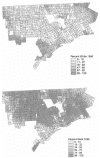Racial and spatial relations as fundamental determinants of health in Detroit
- PMID: 12532644
- PMCID: PMC2690127
- DOI: 10.1111/1468-0009.00028
Racial and spatial relations as fundamental determinants of health in Detroit
Abstract
African Americans in the United States have a higher than average risk of morbidity and mortality, despite declining mortality rates for many causes of death for the general population. This article examines race-based residential segregation as a fundamental cause of racial disparities, shaping differences in exposure to, and experiences of, diseases and risk factors. The spatial distribution of racial groups, specifically the residential segregation of African Americans in aging urban areas, contributes to disparities in health by influencing access to economic, social, and physical resources essential to health. Using the Detroit metropolitan area as a case study, this article looks at the influences of the distribution of African American and white residents on access to these resources and discusses the implications for urban policies to reduce racial disparities in health status.
Figures





References
-
- Anderson RP, Sorlie PD, Backlund E, Johnson N, Kaplan GA. Mortality Effects of Community Socioeconomic Status. Epidemiology. 1997;8:42–7. - PubMed
-
- Aneshensel CS, Sucoff CA. The Neighborhood Context of Adolescent Mental Health. Journal of Health and Social Behavior. 1996;37:293–310. - PubMed
-
- Antonovsky A. Social Class, Life Expectancy, and Overall Mortality. Milbank Quarterly. 1967;45:31–73. - PubMed
-
- Bryant B, Mohai P. Race and the Incidence of Environmental Hazards: A Time for Discourse. Boulder, Colo.: Westview Press; 1992.
-
- Bullard RD. Solid Waste Sites and the Black Houston Community. Sociological Inquiry. 1994;53:273–88. - PubMed

